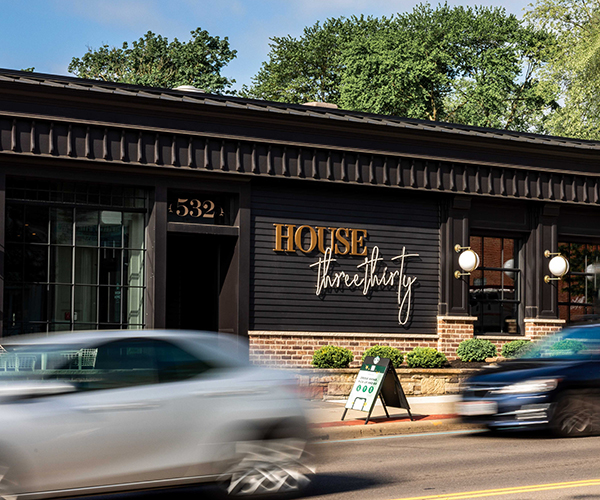He isn’t wearing a cowboy hat, but he might as well. This dude is the old America. The one we’ve known. The one we’ve all grown up in.
He looks my lime-green ride up and down. It’s shaped like a Converse All-Star sneaker. You can fit six bags of groceries in the heel and one person behind the laces. His eyes come back to me and he laughs. I tighten my grip on the wheel. At 6-feet tall, I feel a bit too tall to be in this thing without an adjustable seat. I look ridiculous.
He revs his V-8 engine.
I think about returning the gesture, but he wouldn’t be able to hear the slight increase in electric hum over the idling noise of his truck, so I just give him a slight nod and look ahead.
Here we are — the past and the future facing off at a stoplight.
Yes, this little one-person vehicle produced by Myers Motors is the future, or at least a promise of what it could be. The electric-vehicle company located in suburban Akron has hand-built and sold just 50 cars (officially an “enclosed motorcycle” because it has just three wheels) in the six years it’s been in business. Maybe that’s because the vehicle is so ridiculous looking that it was used as a prop in the Austin Powers: Goldmember movie (granted, it was outfitted with a phallic-looking tailpiece and two rounded fenders on the front meant to resemble, well, you know).
Yet Myers Motors has a claim on the future of the auto industry because vehicles like this one that are fueled by electric power rather than gasoline are entering the mainstream. Chevrolet will soon sell its Volt, Ford is readying an electric version of the Focus, and Nissan will produce a vehicle called the Leaf. And when Myers Motors goes head-to-head with the industry’s big names, it won’t be with the puny gizmo I’m driving. This year, Myers will produce its first two-person vehicle, the Duo (short for Doesn’t Use Oil). It will have all the features everyone thinks of as standards but were lacking in Myers’ first model: power steering, power brakes, cup holders, adjustable heat controls and labels for the dashboard controls. The slick new design was helped along by a $250,000 grant from the Cleveland-based venture development organization JumpStart.
Electric
Company
Duo
Maker: Myers Motors
Cost: $30,000
Range: 60 miles
Gas backup: No
Focus BEV
Maker: Ford
Cost: N/A
Range: 100 miles
Gas backup: No
Leaf
Maker: Nissan
Cost: N/A
Range: 100 miles
Gas backup: No
Volt
Maker: Chevy
Cost: $40,000
Range: 40 miles
Gas backup: Yes
Take away the complicated internal combustion engine, and they’re much easier to build than traditional cars. It’s also less expensive for a new manufacturer to enter the market. That means a business — or many businesses — like little Myers Motors could change the American auto industry as we know it.
The Big 3 could become The Big 30.
The light turns green.
I push the pedal to the floor. I feel my body slam against the back of the seat. The car whirs embarrassingly as I blow his doors off, pulling off the line way faster than the pickup. Of course, I know the top recommended speed of this little guy is 75 miles per hour, so I slow down, get into the turn lane and give a little wave to the pickup driver before he’s able to pass me. He shakes his head side to side with a smile.
• • •
Dana Myers has a Bill Gates look to him. The 51-year-old owner of Myers Motors sort of resembles a dorky kid except his brown hair is mixed with gray. His eyebrows shoot up when he talks about something that excites him. And electric cars excite the holy hell out of him.
“We never got into the single-passenger vehicle market thinking this was the be-all end-all,” he says. “It was our starter vehicle to get our feet wet.”
When you see plans for Myers Motors’ new two-seater and listen to Myers talk about the possibilities, your heart beats a little faster — even if you’re not a gearhead; maybe especially if you’re not a gearhead. Myers makes you believe.
Like his first one, his new vehicle has three wheels and, despite adding another passenger, still has a 60-mile guaranteed range before it needs recharging. The Duo looks slick and tapered. From the front, it resembles a car. From the back, well, let’s just say the third wheel no longer looks like a design flaw.
Myers only sold about 50 of his NmG model (short for No More Gas) after he bought Corbin Motors’ failed Sparrow vehicle and made it his own. He presold that many Duo two-seaters in the seven days after he unveiled plans for it on the Myers Motors Web site. It’s been a long road to get here. When Myers initially bought the Sparrow concept from the California manufacturer that invented it, the vehicle had huge problems. For one it only had a 30-mile range before needing a charge. But there was another, even more troubling, issue.
“You’d go down the road and roll both windows down and the car would shut off,” Myers recalls. “So one of my early engineers said, ‘Just tell people they can’t roll both windows down at the same time.’ I said ‘OK, next engineer, please.’ ”
Myers Motors’ quirky little one-seater may have ended up just another failed attempt at the electric car if it hadn’t been for University of Akron professor Tom Hartley, who approached Myers about borrowing a vehicle to show his students. An electrical engineer, Hartley had helped design battery-management systems for the International Space Station, and he offered to help Myers build a system that allowed for a more efficient and long-lasting lithium battery. It was Hartley’s work that pushed Myers’ vehicles to their current 60-mile range.
Today, that patent on the company’s battery-management system is probably its most valuable business asset. It’s not a stretch to think that these kind of advances by tiny companies such as Myers Motors could be the foundation of a new American automobile industry.
They would be vehicles that do not depend on oil and are based on technology that cannot be replicated. And like any other seismic cultural shift, they would upend our entire way of thinking about making cars and how we use them.
• • •
I pull the Myers Motors NmG into a grocery store parking lot in Akron. It takes up maybe a third of the parking space.
As I power the vehicle down, a group of teenagers in a Chevy Cavalier park next to me. The car’s owner has added a spoiler and spinning rims to it.
“Hey man, what is that?” they ask.
“An electric car.”
“What’s the sound system like?”
I turn on the radio. Then I pump it.
“Man, I would pimp that little car out!” the driver says.
“Yeah, man, it would be bumpin’!” his buddy concurs.
They peel off and an older woman taps the car. “What the heck is this?”
I tell her. She frowns.
“You couldn’t take a lady anywhere in that.”
I nod. She’s right. But she’s not done.
“It looks dangerous.”
• • •
People don’t quite know what to make of an electric car at first sight. That doesn’t even begin to take into account the radical change in thinking it would require to make the leap from pulling into a gas station to parking our vehicles for overnight recharging, which is what both Myers’ NmG and Duo require.
You could say Americans aren’t geared that way, and you’d be right. But if you say Americans aren’t pioneers, you’ll have a fight on your hands. The same goes for Clevelanders because Myers Motors isn’t the first groundbreaking automobile company to call Northeast Ohio home.
In 1897, the Winton Motor Car Co., then known as the Winton Motor Carriage Co., began building cars here. Winton was the first to sell a standard, American-made, gas-powered car. It sold for $1,000. By 1910, the company had marketed 18 automobile models. It produced 2,450 cars in 1916 alone. But when Henry Ford introduced the more affordable, mass-produced Model T, Winton couldn’t compete and folded in 1924. Ford, of course, went on to become the company discussed in economics and history classes. Winton ended up a footnote.
Still, Cleveland’s economy thrived on manufacturing for years. After World War II, the wartime plants that had assembled B-29s and P-75s started producing parts for American car companies. By 1947, 10 percent of our city’s work force was somehow tied to the automobile industry.
We made the steel for those cars as business swelled and contracted throughout the ’70s, ’80s and ’90s, and Akron was once home to three major tire manufacturers. Goodyear remains headquartered there to this day.
Cars and our relationship to making them helped our parents buy houses and put many of us through college. That’s why it’s bittersweet that so many hollowed out automobile plants dot our landscape and those who still build cars here deal with constant fears that the doors of their plant could close.
Sure, a guy who spent his life building Econoline vans at the Lorain Assembly Plant would likely be wary of buying an electric car — right now at least. But if you said autoworkers just like him who have seen their jobs disappear wouldn’t be interested in building one, you’d be dead wrong.
• • •
Heading back to Myers Motors after my test drive, I’m looking for the tiny sign that marks the driveway. I miss it and head into Tallmadge Circle.
By now, I’m not test-driving some wacky vehicle. I’m just driving, trying to figure out how to get back. Dana Myers said he drove the vehicle I’m in to Cuyahoga Falls earlier in the day, and the battery is flirting with the low end of the power spectrum.
This is when the reality of an electricity-fueled car culture hits me. Sure, it seems appealing to never pull into a gas station again and to spend less than two cents per mile on fuel, but it would also mean taking less out-of-the-way trips. Transportation would require planning. Whenever I do that, I end up shopping in my neighborhood, becoming part of my community. There are so many potentially positive side effects.
But, this is America. Willie Nelson, the Allman Brothers and Bruce Springsteen have all made us fall in love with the idea of hitting the road. And while most people don’t often take trips longer than a few hundred miles, the idea that we can do it easily is what has given the car its power in our lives.
It’s why we were so excited to turn the key at 16 years old and stare down the interstate knowing we could go to New York or Chicago or Nashville or anywhere that was connected to us by the asphalt under our tires.
• • •
Right now, you probably wouldn’t buy a car that uses new technology from a small company that builds only a few thousand vehicles a year. But what happens to the public’s perception of electric cars when Chevrolet and Ford start putting models on the market? We’ll find out during the next year.
Tom Ganley has peddled a lot of cars in Cleveland. He owns the largest auto empire in Ohio with more than 32 dealerships, and he’ll sell both the Chevy Volt and the electric Ford Focus when they’re released. You can hear the wonder in his voice when he talks about it. It doesn’t sound like he’s trying to sell a car so much as it sounds like he’s trying to sell his first car.
“It’s the coming technology,” he says. “The biggest challenge they face with electric vehicles is trying to establish a range — how far they can go before they need to be recharged.”
The Volt has a 40-mile battery range, but it also has a gas motor that will kick in if the car runs out of juice. Chevy likes to point out that the Volt will cover 75 percent of its owner’s trips without using gas. And while it gets at least 20 miles less per charge than Myer Motors’ Duo, it has four seats. It’s also more expensive: The Volt is $40,000 compared to the $30,000 Duo.
Ganley expects that the electric cars he sells this year will be purchased by a niche segment of customers. But you can almost hear his imagination click into gear when he starts talking about what this technology could end up meaning.
“I don’t think it’s too far into the future when the batteries get significantly smaller,” he says. “That will make for some very interesting automobiles. If you don’t have to have that big internal combustion engine, ... that allows you to have some very unique opportunities to design automobiles. This could be radical.”
But let’s not get ahead of ourselves. Charles Territo, spokesman for the Washington D.C.-based Alliance of Automobile Manufacturers, says it will be a while before the mass production of electric vehicles. “Keep in mind that it took almost 10 years to sell just a million hybrid electric vehicles worldwide,” he says.
The big obstacle, he says, is making electric cars acceptable to the average buyer. They will have to provide what appears to be a seamless transition from the internal combustion engine. They will also have to cost about the same as a gas-powered vehicle. But once those prices fall in line with traditional automobiles, Dana Myers plans to stay ahead of the electricity-fueled pack.
He wants Myers Motors to be the Kia of the electric-vehicle industry — reliable but always less expensive than its closest competitor. And he’s willing to embrace whichever direction growth takes his company. Because the Myers Motors’ patents are the backbone of its business, the company could opt to franchise the technology to others. Mom-and-pop Myers Motors locations could open throughout the country, each with a local owner, using local workers to produce vehicles.
But first, he’ll start small. Myers projects he’ll sell 1,000 of his two-seaters before he starts production in the spring. He has also offered an incentive: If 1,000 people commit to buying one of his cars, he’ll drop the price from $30,000 to $25,000. He can afford to do that because he’ll be buying supplies in bulk. After spending years purchasing parts from “ a guy who made them in his garage,” Myers says, he has finally sorted out his supply chain — that’s the first step to going from a fledgling car company to a viable small one, and that’s all that the company is really focused on right now.
Myers may be dreamer, but he’s not a fool.
“We are just a gnat on the elephant that is the automakers,” Myers says. “It would be arrogant to think we can influence them. But I don’t think it’s arrogant to suggest we can survive, we can thrive.”



